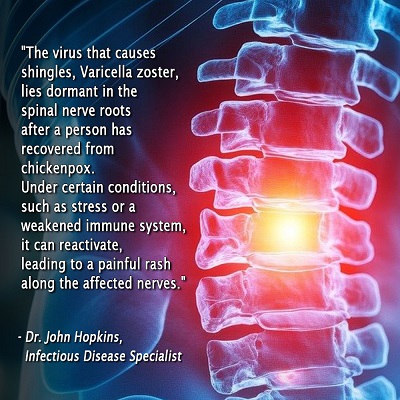 Have you ever experienced shingles? If you have, you know how painful it can be. If you haven’t, shingles is a viral skin infection that causes a painful rash.
Have you ever experienced shingles? If you have, you know how painful it can be. If you haven’t, shingles is a viral skin infection that causes a painful rash.
The Varicella-Zoster Virus Explained
Shingles is caused by the varicella-zoster virus (VZV). It’s the same type of virus that causes chickenpox. If you’ve suffered with chickenpox before, you’re at risk of getting shingles.
After you’ve recovered from chickenpox, the virus may not leave your body completely. Instead, it may hide in an inactive state in your spinal cord’s nerve root. It’s when your immune system becomes weakened and lets you down that the virus may activate and reproduce in great numbers. This results in the skin rash and pain, because there are plenty of nerve endings in that area.
Shingles can be contagious, however, instead of contracting shingles, the other person may get chickenpox. Shingles spreads not by breathing in the virus, but by getting in contact with the fluids from the blisters.
Signs and Symptoms of Shingles
The signs of shingles mostly appear on the skin, and can appear in different places depending where it is living in your spinal cord. Some people have the rash show on their face, back, buttocks, anywhere really, and usually in the same place if they have had it before. The rash can also wrap around your torso or appear on one side only of your face or neck.
Some people may experience intense pain, and some shingles don’t ever develop into a rash.
Here are some more of the common symptoms:
- Pain, tingling, and burning sensations on one specific side of your body, which is often the first signs of a shingles outbreak.
- A red rash in a band-like pattern that usually develops after a few days of feeling a pain sensation.
- Fluid-filled blisters that break and crust over.
- Itching and sensitivity to the touch, when on the affected area.
- Fever and headache, or sensitivity to light.
The Shingles Lifecycle
Here’s what happens to the Varicella-Zoster Virus that causes shingles:
- Reactivation – The dormant virus reactivates. This can be triggered by a weakened immune system or stress.
- Prodrome Stage – The virus starts activity and early signs of shingles begin – the pain, the tingling, or itching in a specific area.
- Active Stage – The virus becomes active, materializing in a rash and blisters. It usually lasts 2-4 weeks. During this time, the virus can be contagious and spread to others, especially those who have never had chickenpox.
- Healing Stage – Blisters crust over and heal. The pain may still linger, called postherpetic neuralgia (PHN), and can last for months or even years.
Potential Complications of Shingles
Shingles can lead to long-term and serious complications, such as long-term nerve pain, vision loss, hearing problems or infections.
These complications depend on where the shingles rash is located. PHN can be extremely painful to the point that it can affect your daily life. Senior adults are more at risk of experiencing postherpetic neuralgia (PHN) than people under the age of 40.
Prevention and Treatment of Shingles
Living a healthy lifestyle and fortifying your immune system is the best way to prevent a bout of shingles. Make sure you are eating plenty of clean, non-processed foods, getting enough sleep, managing your stress levels, and nixing any bad habits that may be weakening your immune system.
Early treatment can help reduce symptoms of shingles, speed up recovery, and prevent further complications. Doctors may treat shingles with antiviral medications to help reduce the severity and duration of the symptoms. However, you need to see your doctor as soon as possible, as it is best if they are administered within the first 72 hours of the rash appearing.
In some cases, corticosteroids are prescribed to reduce inflammation and pain. They’re usually given in conjunction with antiviral medications.
You can also take pain relief medications to manage the pain, which is crucial. There are over-the-counter pain relievers like Tylenol and ibuprofen, but for more severe pain, you may need prescription medications. There are also topical treatments containing capsaicin or lidocaine that can help numb the painful area.
Make sure that you get plenty of rest to help your body fight the virus, and don’t hesitate to see your doctor right away. With early treatment, you can reduce the severity and duration of the symptoms, which is a very good thing!






